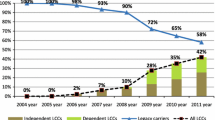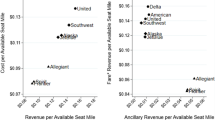Abstract
The paper examines the impact of low-cost carrier Pegasus Airlines’ entry on Turkish Airlines’ yields in domestic and international routes. We find that Turkish Airlines’ yields are lower in both types of routes in response to entry. Moreover, the LCC entry affects domestic routes substantially more than international routes. Due to lower fares and heightened competition, the number of passengers has more than quadrupled in the last decade. Hence, we argue that Pegasus entry has been instrumental in transforming the Turkish Airline industry, which has become more dynamically competitive recently.


Similar content being viewed by others
Notes
To our knowledge, Oliveira and Huse (2008) investigating price reactions to the entry of the low-cost carrier Gol Airlines in the Brazilian domestic market in 2001 is the only study on low cost carrier competition in a developing country context.
This section is based on Dursun et al. (2014) in which a detailed overview of the Turkish airline industry is provided.
Our methodology is similar to Goolsbee and Syverson (2008) and Aydemir (2012) where they look at 25-quarter window and 13-quarter window, respectively. However, due to data unavailability, in the earlier version of the paper we considered a relatively modest 13-month window to be able to study as many markets as possible that satisfy the criteria below. One of the referees suggested that a 13-month window is appropriate for international markets but that we should extend the window size for domestic markets. After checking for robustness, we find that the suggestion turns out to be right. Hence, following the advice, we look at 19-month and 13-month windows for the domestic and international markets, respectively, in the current version of the paper. Note that we lose one market from the domestic markets sample by extending the window size from thirteen to nineteen.
The empirical specification is similar to Aydemir (2012) who focus on the effects of actual and potential competition in the US airline industry. Here, we analyze only actual competition due to unavailability of data. In the international markets analysis, we exclude the first three before entry and the last three after entry dummies from the specification (1) to look at 13-month window (six months before and six months after entry).
References
Alderighi, M., Cento, A., Nijkamp, P., & Rietveld, P. (2012). Competition in the European aviation market: The entry of low-cost airlines. Journal of Transport Geography, 24, 223–233.
Aydemir, R. (2012). Threat of market entry and low cost carrier competition. Journal of Air Transport Management, 23, 59–62.
CAPA (2015). Pegasus Airlines & Turkish Airlines: Turkey’s aviation booms, Istanbul Sabiha Gokcen Airport gains. http://centreforaviation.com/analysis/pegasus-airlines–turkish-airlines-turkeys-aviation-booms-istanbul-sabiha-gokcen-airport-gains-218461 Accessed 15 August 2015.
Davidson, R., & MacKinnon, J. G. (1993). Estimation and inference in econometrics. Oxford: Oxford University Press.
Dresner, M., Lin, J.-S. C., & Windle, R. (1996). The impact of low-cost carriers on airport and route competition. Journal of Transport Economics and Policy, 30(3), 309–328.
Dursun, M. E., O’Connell, J. F., Lei, Z., & Warnock-Smith, D. (2014). The transformation of a legacy carrier: A case study of Turkish Airlines. Journal of Air Transport Management, 40, 106–118.
Forsyth, P. (2003). Low-cost carriers in Australia: Experiences and impacts. Journal of Air Transport Management, 9, 277–284.
Gerede, E. (2010). The evolution of Turkish air transport industry: Significant developments and the impacts of 1983 liberalization. Yönetim ve Ekonomi, 17(2), 64–91.
Goolsbee, A., & Syverson, C. (2008). How do incumbents respond to the threat of entry? Evidence from the major Airlines. Quarterly Journal of Economics, 6, 1611–1633.
Greene, W. H. (2008). Econometric analysis. Tulsa: Granite Hill Publishers.
Homsombat, W., Lei, Z., & Fu, X. (2013). Competitive effects of the Airlines-within-Airlines strategy—Pricing and route entry patterns. Transportation Research Part E, 63, 1–16.
Morrison, S. (2001). Actual, adjacent, and potential competition: Estimating the full effect of Southwest Airlines. Journal of Transport Economics and Policy, 32, 239–256.
MTMC (2015). Republic of Turkey Ministry of Transport and Communication, Havacilik ve Uzay Teknolojileri Raporu 2014. Aviation and Space Technologies Report 2014. http://ubak.gov.tr/images/faaliyet/a5ec26a31a72281.pdf. Accessed 15 August 2015.
Nenem, M. S., & Ozkan-Gunay, E. N. (2012). Determining hub efficiency in Europe, the Middle East, and North Africa: The impact of geographical positioning. Eurasian Economic Review, 2(2), 37–53.
Oliveira, A. V. M. (2008). An empirical model of low-cost carrier entry. Transportation Research Part A, 42, 673–695.
Oliveira, A. V. M., & Huse, C. (2008). Localized competitive advantage and price reactions to entry: Full-service vs. low-cost Airlines in recently liberalized emerging markets. Transportation Research Part E, 45, 307–320.
Pegasus. (2013). Press release: First flight to Moscow. http://www.flypgs.com/pegasus-hakkinda/haberler/806/moskova-ilk-ucus.aspx. Accessed 17 October 2015.
Tourism-Review. (2013). Turkish Low-Cost Airline Pushes Ticket Prices Down. http://m.tourism-review.com/low-cost-airline-from-turkey-pushes-prices-of-competition-lower–news3909. Accessed 15 August 2015.
Windle, R., & Dresner, M. (1999). Competitive response to low cost carrier entry. Transportation Research Part E, 35, 59–75.
Wooldridge, J. M. (2010). Econometric analysis of cross section and panel data. Cambridge: MIT Press.
Acknowledgments
The views expressed in this paper are those of the authors and do not necessarily reflect the views of Turkish Airlines. We thank to the editor, Peter Rangazas and the referees for their valuable comments and recommendations.
Author information
Authors and Affiliations
Corresponding author
Appendix: Robustness checks
Appendix: Robustness checks
1.1 Domestic markets
1.2 International markets
Rights and permissions
About this article
Cite this article
Aydemir, R., Haytural, C. The effects of low cost carrier entry in the Turkish Airline industry. Eurasian Econ Rev 6, 111–124 (2016). https://doi.org/10.1007/s40822-015-0039-0
Received:
Revised:
Accepted:
Published:
Issue Date:
DOI: https://doi.org/10.1007/s40822-015-0039-0




